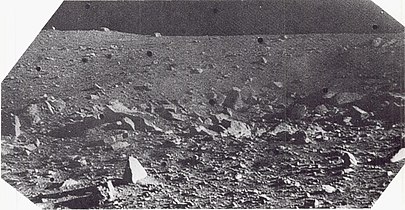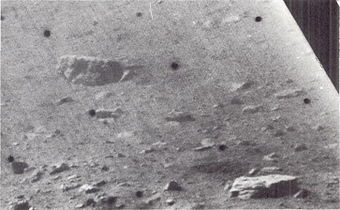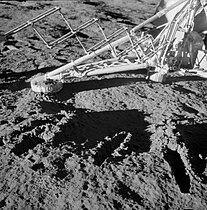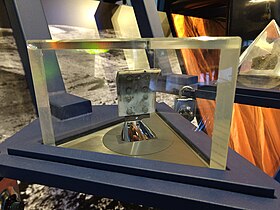Surveyor 3
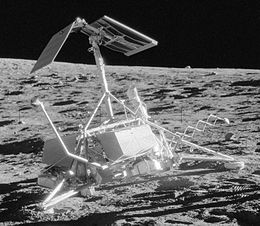 | |
| Mission type | Lunar lander |
|---|---|
| Operator | NASA |
| COSPAR ID | 1967-035A |
| SATCAT no. | 02756 |
| Mission duration | 16 days (launch to last contact) |
| Spacecraft properties | |
| Manufacturer | Hughes Aircraft |
| Launch mass | 1,026 kilograms (2,262 lb)[1] |
| Landing mass | 296 kilograms (653 lb) |
| Start of mission | |
| Launch date | April 17, 1967, 07:05:01 UTC LC-36B |
| End of mission | |
| Last contact | May 3, 1967 |
| Lunar lander | |
| Landing date | April 20, 1967, 00:04:53 UTC |
| Landing site | 3°00′58″S 23°25′04″W / 3.01612°S 23.41791°W |
Surveyor 3 is the third
Surveyor 3 was visited by Apollo 12 astronauts Pete Conrad and Alan Bean in November 1969, and remains the only probe visited by humans on another world. The Apollo 12 astronauts excised several components of Surveyor 3, including the television camera, and returned them to Earth for study.
History
Launched on April 17, 1967, Surveyor 3 landed on April 20, 1967, at the
As Surveyor 3 was landing in the crater[3][4] highly reflective rocks confused the spacecraft's lunar descent radar. The engines failed to cut off at 14 feet (4.3 meters) in altitude as called for in the mission plans, and this delay caused the lander to bounce on the lunar surface twice.[5] Its first bounce reached the altitude of about 35 feet (11 meters). The second bounce reached a height of about 11 feet (3.4 metres). On the third impact with the surface – from the initial altitude of 3 meters, and velocity of zero, which was below the planned altitude of 14 feet (4.3 meters), and very slowly descending – Surveyor 3 settled down to a soft landing as intended.
This Surveyor mission was the first that carried a surface-soil sampling-scoop, which can be seen on its extendable arm in the pictures. This mechanism was mounted on an electric-motor-driven arm and was used to dig four trenches in the lunar soil. These trenches were up to 7 inches (17.8 centimeters) deep. Samples of soil from the trenches were placed in front of the Surveyor's television cameras to be photographed and the pictures radioed back to the Earth. When the first lunar nightfall came on May 3, 1967, Surveyor 3 was shut down because its solar panels were no longer producing electricity. At the next lunar dawn (after 14 terrestrial days, or about 336 hours), Surveyor 3 could not be reactivated, because of the extremely cold temperatures that it had experienced. This is in contrast with the Surveyor 1, which was able to be reactivated twice after lunar nights, but then never again.[6]
Surveyor 3 became famous after the crew of Apollo 12 used it as a landing target site. Landing within walking distance on November 19, 1969, the astronauts took several pictures of the probe and removed a scoop from the probe's soil mechanics-surface sampler, a section of unpainted aluminum tube from a strut supporting the Surveyor's radar altimeter and Doppler velocity sensor, another section of aluminum tube that was coated with inorganic white paint and a segment of television cable wrapped in aluminized plastic film and the Surveyor 3's television camera which were returned to Earth.[7] Surveyor 3 is the only probe visited by humans on another world.
Science instruments
Television
The television camera on Surveyor 3 consisted of a
The Apollo 12 Lunar Module landed near Surveyor 3 on November 19, 1969. Astronauts Conrad and Bean examined the spacecraft, and they brought back about 10 kilograms (22 lb) of parts of the Surveyor to the Earth, including its TV camera, which is now on permanent display in the National Air and Space Museum in Washington, D.C.
-
Panorama of the mare surface
-
Angular blocks, up to 2 metres (6 ft 7 in) in diameter, which form part of a strewn field of blocks that surround a sharp-rim crater 3 metres (9.8 ft) in diameter
-
Similar view but with different lighting
-
Blocky fragments on north wall of crater in which the spacecraft is located
Soil mechanics surface sampler
The soil mechanics surface sampler was designed to dig, scrape, and trench the lunar surface and to transport lunar surface material while being photographed so that the properties of the lunar surface could be determined. The sampler was mounted below the television camera and consisted primarily of a scoop approximately 120 mm long and 50 mm wide. The scoop consisted of a container, a sharpened blade, and an
-
An engineering model of Surveyor 3, S-10, used for thermal control tests, reconfigured to represent a flight model of Surveyor 3 or later, at the National Air and Space Museum (NASM)
-
Three-quarter view from below of Surveyor engineering model (NASM)
-
Surveyor 3 camera brought back from the Moon by Apollo 12, on display at NASM
-
Surveyor 3 scoops, photographed by the Apollo 12 astronauts
-
Soil mechanics surface sampler from the Surveyor 3 spacecraft returned to Earth by the crew of Apollo 12
Apollo 12 and the possibility of interplanetary contamination
The Surveyor 3 landing site was later selected also as the landing target for the
It is widely claimed that a common type of
However, independent investigators have challenged the claim of surviving bacteria on Surveyor 3 on the Moon. There is a possibility the contamination was caused by using a non-airtight container,[11] or when the samples were being taken in the clean room after Apollo 12.[11][12]
Lunar Reconnaissance Orbiter

In 2009, the Lunar Reconnaissance Orbiter (LRO) photographed the Surveyor 3 landing site in some detail, in which surrounding astronaut foot tracks could also be seen.[13] In 2011, the LRO returned to the landing site at a lower altitude to take higher resolution photographs.[14]
See also
References
- ^ a b "Surveyor 3". NASA Space Science Data Coordinated Archive. Retrieved 2022-12-02.
- ^ "First image of Earth from the surface of the Moon: Surveyor 3".
- ^ "Surveyor Crater and Surveyor III". www.hq.nasa.gov.
- ^ "nasa.gov Contour Map of Surveyor Crater". Archived from the original on 2013-03-17. Retrieved 2009-09-02.
- ^ Thurman, Sam W. (February 2004). SurveyorSpacecraft Automatic Landing System. 27th Annual AAS Guidance and Control Conference. Archived from the original on 2008-02-27.
- ^ Krebs, Gunter D. "Surveyor 1, 2, 3, 4, 5, 6, 7". Gunter's Space Page. Retrieved 2023-05-08.
- ^ "50 Years on, Where Are the Surveyor 3 Moon Probe Parts Retrieved by Apollo 12?". Space.com. 2019-11-23.
- ^ NASA SP-184 - SURVEYOR Program Results (PDF). NASA. 1969. p. 109.
- ^ "NASA – NSSDCA – Spacecraft – Details". nssdc.gsfc.nasa.gov. Retrieved 2017-08-14.
- ^ "Earth microbes on the Moon". Science.nasa.gov. Archived from the original on 2010-03-23. Retrieved 2009-07-20.
- ^ a b David, Leonard (2011-05-02). "Moon Microbe Mystery Finally Solved". Space.com. Retrieved 2011-05-15.
- ^ John D. Rummel; Judith H. Allton; Don Morrison (2011). "A Microbe on the Moon? Surveyor III and Lessons Learned for Future Sample Return Missions" (PDF).
- ^ "Lunar Reconnaissance Orbiter images of the Surveyor 3 landing site". Retrieved 2009-09-04.
- ^ "Lunar Reconnaissance Orbiter returns to the Apollo 12/Surveyor 3 landing site in 2011". 2015-02-24.
External links
- Surveyor Program Results (PDF) 1969
- Analysis of Surveyor 3 material and photographs returned by Apollo 12 (PDF, 24 MB) 1972
- Surveyor 3 images at Lunar and Planetary Institute
- Surveyor Site III Lunar Map at Lunar and Planetary Institute
- Surveyor Site III Lunar Photomap at Lunar and Planetary Institute


